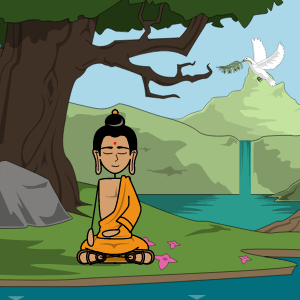Budizm Gerçekleri

Bu hikaye tablosunu aşağıdaki makalelerde ve kaynaklarda bulabilirsiniz:

Budizm: Kökenler ve Tarih
Tarafından Liane Hicks
Budizm dünya çapında 500 milyondan fazla insan tarafından uygulanmaktadır ve dünyanın dördüncü büyük dinidir. Budizm yaklaşık 2.500 yaşındadır ve 6. yüzyılda Buda'nın öğretilerine dayanarak başlamıştır. Barış ve huzuru, ahlaklı ve güzel bir hayat sürmenin önemini merkeze almış bir dindir.
'
Öykü Açıklama
Öğrencilerin Budizm hakkında farklı gerçekleri açıklamalarını ve örneklendirmelerini sağlayın. Şu sorulara cevap verebilirler: Din nereden çıktı?: Kurucuları kimlerdi?: Ne zaman başladı?; Temel inançlardan bazıları nelerdir?; Bazı kutsal nesne veya sembol örnekleri nelerdir?: Takipçileri nasıl ibadet eder / ibadethaneler; Manevi liderleri kimlerdir?, vb.
Öykü Penceresi Metni
- Slayt: 1
- PLACE OF ORIGIN
- Ancient India / Lumbini Province, Nepal
- Buddhism was founded by Siddhartha Gautama, who was a Hindu prince born in the Lumbini Province near the Himalayan mountains in Ancient India, modern day Nepal.
- Slayt: 2
- YEARS IT BEGAN
- 6th Century BCE
- Siddhartha Gautama was born circa 623 BCE. He traveled throughout India teaching his ideas about inner peace and how to end suffering. He is known as the Buddha. In the 3rd century B.C., Ashoka the Great, the Mauryan Indian emperor, made Buddhism the state religion of India. While Buddhism in India eventually declined, over the next few centuries, Buddhism spread beyond India to much of east and southeast Asia.
- Slayt: 3
- FOUNDERS
- Siddhartha was a Hindu prince. Upon discovering sickness, old age, and death outside the palace walls, he left his privileged life to meditate and seek an answer to the root causes of human suffering. He achieved enlightenment at the age of 35 after meditating for several days under what is known as the Bodhi tree and became the Buddha. He taught his followers that the way to Nirvana was by following the Four Noble Truths and the Eightfold path.
- Slayt: 4
- BELIEFS
- The Eightfold Path
- Right Understanding
- Right Concentration
- Right Thought
- Right Mindfulness
- Right Effort
- Right Livelihood
- Right Speech
- Right Action
- The Buddha taught Four Noble Truths: 1) All life involves suffering; 2) Selfish desires are a cause of suffering; 3) People can end their suffering by giving up selfish desires and reach Nirvana; 4) Following the Eightfold Path will help one to reach Nirvana. Buddhists also believe in reincarnation. People are reborn after dying and go through cycles of birth, living, death, and rebirth. They believe that one should do no harm to any living thing.
- Slayt: 5
- SYMBOLS OBJECTS
- Mala are prayer beads used in Buddhism and other religions. Prayer wheels contain a tightly scrolled paper of a mantra or prayers. When spun, the prayers sent out multiply. Other sacred objects are prayer bells, conch shells, singing bowls, statues of the Buddha, and the Om which represents the ultimate reality, consciousness, or Atman.
- Slayt: 6
- HOUSES OF WORSHIP
- A Buddhist temple or monastery is a place of worship for Buddhists. They include a vihara, chaitya, wat, pagoda, and stupa. Stupas are dome-shaped structures erected as Buddhist shrines. They contain relics, typically the ashes of Buddhist monks, and are used by Buddhists as a place of meditation.
- Slayt: 7
- SPIRITUAL LEADERS
- “I believe that the very purpose of life is to be happy. From the very core of our being, we desire contentment. ... Since we are not solely material creatures, it is a mistake to place all our hopes for happiness on external development alone. The key is to develop inner peace.”
- While there are different sects of Buddhism, the Dalai Lama is the spiritual leader of the Tibetan Buddhists. He was awarded the Nobel Peace Prize in 1989 and the U.S. Congressional Gold Medal in 2007. Dalai Lama means Ocean of Wisdom. Other Buddhist leaders include monks, who are usually men, and nuns, who are women.
- Slayt: 8
- POPULATION TODAY
- Over 500 Million Followers
- All over the world but mainly in East and Southeast Asia
- Buddhists represent about 7% of the world's population. People practice Buddhism throughout the world but most are located in east and southeast Asia in China, Nepal, India, Sri Lanka, Myanmar, Cambodia, Laos, Thailand, Korea, and Japan.
30 Milyondan Fazla Storyboard Oluşturuldu
İndirme Yok, Kredi Kartı Yok ve Denemek İçin Giriş Gerekmiyor!






